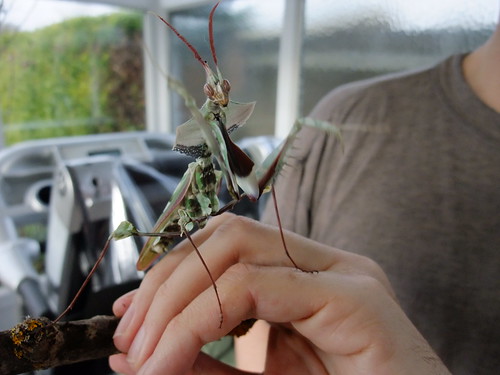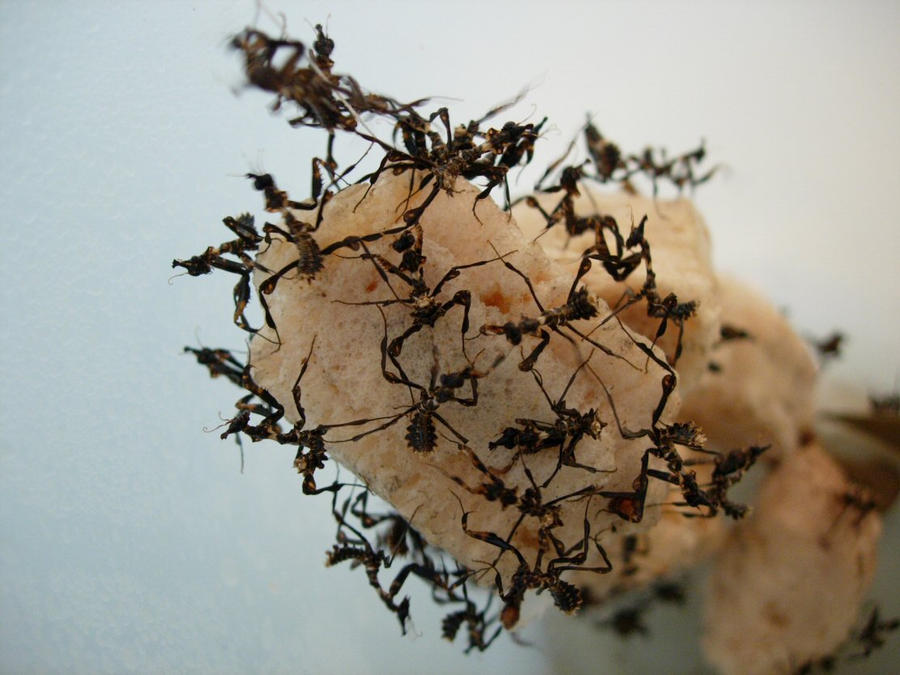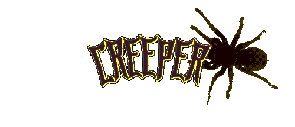Post by Creeper on Apr 30, 2015 8:33:09 GMT 5
Giant Devil's Flower Mantis - Idolomantis diabolica

Scientific classification
Kingdom: Animalia
Phylum: Arthropoda
Class: Insecta
Order: Mantodea
Family: Empusidae
Subfamily: Blepharodinae
Genus: Idolomantis
Species: Idolomantis diabolica
Idolomantis diabolica, commonly known as the Devil's Flower Mantis or Giant Devil's Flower Mantis, is one of the largest species of praying mantis, possibly the largest that mimics flowers. It is the only species in its genus, Idolomantis.
Description
Idolomantis diabolica is a large mantis, females may grow to be about 13 centimetres (5") in length and males to about 10 centimetres (4"). They are native to Ethiopia, Kenya, Malawi, Somalia, Tanzania, and Uganda. Its threat display is magnificently colored, with red, white, blue, purple and black.

Anatomy
The anatomical structure of the Idolomantis diabolica is almost identical to species of the mantodea order, however, the morphology of each species varies according to the native habitat.
The head of the Idolomantis diabolica contains three vital components: compound eyes, antennas, and mandibles. The compound eyes, composed of thousands of individual photoreceptor cells, facilities sight. The photoreceptor units, for instance, allows the insect to capture a perceptual span of 180 degrees. Consequently, allowing the Idolomantis diabolica to identify prey and predators without hindering its vulnerability. The antennas, a pair of long and thin bristles, serves as the insect's sensory perception. Projecting outwards, the antennas can detect "chemical cues, motion, and odours". The mandibles, denoted as the "jaws" of an insect, acts as a food processor. For example, the mandibles can be used to "tear, puncture, or grind" food.
The thorax constitutes a large portion of the insect's body. In fact, it is composed of three sections: the "prothorax, mesothorax, and metathorax". Each section "contains one pair of legs, however, the wings are found only on the mesothoracic and metathoracic segments."
Reproductive organs, respiratory organs, and other organ systems occupy the abdomen region of the insect. Sclerites reside above the abdomen region to prevent puncture or fracture to the internal organs.
Behavior
Defensive
In the event of being confronted by a predator, the Idolomantis diabolica initiates a deimatic display in an attempt "to scare off or momentarily distract a predator". Its front legs, specifically the femur, are risen to expose the conspicuous patterns depicted on the bottom of the thorax and abdomen. Similarly, the wings display a combination of vibrant colours. Observational analysis of the Idolomantis diabolica in captive settings revealed an additional tactic of shifting its wings left to right to startle and confuse predators.
Predatory
In the presence of prey, the Idolomantis diabolica, impersonating a flower, remains motionless. The objective is to seduce the insect into its striking zone. In this zone, the Idolomantis diabolica utilizes the tibia portion of its leg to grasp and maintain a strong grip on the prey. The mandibles are then "wielded as formidable weapons" to decapitate and devour the prey. The dietary preference of the Idolomantis diabolica is exclusive to airborne insects, specifically "flies, moths, butterflies and beetles."

Reproduction
Copulation
Before reproducing, mature females display dimorphic features in an attempt to attract males. Females lower the "tip of their abdomen and raising the wings slightly to expose more of the uppermost side of the abdomen, thus releasing pheromone to attract a mate". However, sexual cannibalism is prominent among pairs of Idolomantis diabolica that remain in captivity. Due to its precautions nature, intrusive environments conjure up aggressive behaviour. For example, a female, in the process of copulating, adapt predatorial instincts in which often concludes with the female devouring the head of the male.
Nymphs
Females deposit eggs in an ootheca constructed to withstand approximately ten to fifty nymphs. The incubation period varies according to temperature and humidity, however, observational analysis reveals an average duration of fifty days is required for hatching. Upon entering the instar stage, the developmental period of an insect, the nymphs feed on small insects such as houseflies and fruit flies. In addition, "males will develop into adults after about 7 moultings, while females develop after 8 moultings". The average lifespan of the Idolomantis diabolica varies according to the habitat, however, the average lifespan is twelve months.
Pet Trade
Due to its beauty and dramatic displays, the Idolomantis diabolica is considered a prestigious pet. Consumers, specifically in the western hemisphere, purchase thousands on a yearly basis.
References
The phylogenetic system of Mantodea
Devil's Flower Mantis Care - KeepingInsects.com
usamantis.com/idolo_log.html
thedancingrest.com/2015/03/11/idolomantis-diabolica-aka-devils-flower-mantis-or-giant-devils-flower-mantis/

Scientific classification
Kingdom: Animalia
Phylum: Arthropoda
Class: Insecta
Order: Mantodea
Family: Empusidae
Subfamily: Blepharodinae
Genus: Idolomantis
Species: Idolomantis diabolica
Idolomantis diabolica, commonly known as the Devil's Flower Mantis or Giant Devil's Flower Mantis, is one of the largest species of praying mantis, possibly the largest that mimics flowers. It is the only species in its genus, Idolomantis.
Description
Idolomantis diabolica is a large mantis, females may grow to be about 13 centimetres (5") in length and males to about 10 centimetres (4"). They are native to Ethiopia, Kenya, Malawi, Somalia, Tanzania, and Uganda. Its threat display is magnificently colored, with red, white, blue, purple and black.

Anatomy
The anatomical structure of the Idolomantis diabolica is almost identical to species of the mantodea order, however, the morphology of each species varies according to the native habitat.
The head of the Idolomantis diabolica contains three vital components: compound eyes, antennas, and mandibles. The compound eyes, composed of thousands of individual photoreceptor cells, facilities sight. The photoreceptor units, for instance, allows the insect to capture a perceptual span of 180 degrees. Consequently, allowing the Idolomantis diabolica to identify prey and predators without hindering its vulnerability. The antennas, a pair of long and thin bristles, serves as the insect's sensory perception. Projecting outwards, the antennas can detect "chemical cues, motion, and odours". The mandibles, denoted as the "jaws" of an insect, acts as a food processor. For example, the mandibles can be used to "tear, puncture, or grind" food.
The thorax constitutes a large portion of the insect's body. In fact, it is composed of three sections: the "prothorax, mesothorax, and metathorax". Each section "contains one pair of legs, however, the wings are found only on the mesothoracic and metathoracic segments."
Reproductive organs, respiratory organs, and other organ systems occupy the abdomen region of the insect. Sclerites reside above the abdomen region to prevent puncture or fracture to the internal organs.
Behavior
Defensive
In the event of being confronted by a predator, the Idolomantis diabolica initiates a deimatic display in an attempt "to scare off or momentarily distract a predator". Its front legs, specifically the femur, are risen to expose the conspicuous patterns depicted on the bottom of the thorax and abdomen. Similarly, the wings display a combination of vibrant colours. Observational analysis of the Idolomantis diabolica in captive settings revealed an additional tactic of shifting its wings left to right to startle and confuse predators.
Predatory
In the presence of prey, the Idolomantis diabolica, impersonating a flower, remains motionless. The objective is to seduce the insect into its striking zone. In this zone, the Idolomantis diabolica utilizes the tibia portion of its leg to grasp and maintain a strong grip on the prey. The mandibles are then "wielded as formidable weapons" to decapitate and devour the prey. The dietary preference of the Idolomantis diabolica is exclusive to airborne insects, specifically "flies, moths, butterflies and beetles."

Reproduction
Copulation
Before reproducing, mature females display dimorphic features in an attempt to attract males. Females lower the "tip of their abdomen and raising the wings slightly to expose more of the uppermost side of the abdomen, thus releasing pheromone to attract a mate". However, sexual cannibalism is prominent among pairs of Idolomantis diabolica that remain in captivity. Due to its precautions nature, intrusive environments conjure up aggressive behaviour. For example, a female, in the process of copulating, adapt predatorial instincts in which often concludes with the female devouring the head of the male.
Nymphs
Females deposit eggs in an ootheca constructed to withstand approximately ten to fifty nymphs. The incubation period varies according to temperature and humidity, however, observational analysis reveals an average duration of fifty days is required for hatching. Upon entering the instar stage, the developmental period of an insect, the nymphs feed on small insects such as houseflies and fruit flies. In addition, "males will develop into adults after about 7 moultings, while females develop after 8 moultings". The average lifespan of the Idolomantis diabolica varies according to the habitat, however, the average lifespan is twelve months.
Pet Trade
Due to its beauty and dramatic displays, the Idolomantis diabolica is considered a prestigious pet. Consumers, specifically in the western hemisphere, purchase thousands on a yearly basis.
References
The phylogenetic system of Mantodea
Devil's Flower Mantis Care - KeepingInsects.com
usamantis.com/idolo_log.html
thedancingrest.com/2015/03/11/idolomantis-diabolica-aka-devils-flower-mantis-or-giant-devils-flower-mantis/


